
A meteorite is a solid piece of debris from an object, such as a comet, asteroid, or meteoroid, that originates in outer space and survives its passage through the atmosphere to reach the surface of a planet or moon. When the original object enters the atmosphere, various factors such as friction, pressure, and chemical interactions with the atmospheric gases cause it to heat up and radiate energy. It then becomes a meteor and forms a fireball, also known as a shooting star; astronomers call the brightest examples "bolides". Once it settles on the larger body's surface, the meteor becomes a meteorite. Meteorites vary greatly in size. For geologists, a bolide is a meteorite large enough to create an impact crater.

Tektites are gravel-sized bodies composed of black, green, brown or grey natural glass formed from terrestrial debris ejected during meteorite impacts. The term was coined by Austrian geologist Franz Eduard Suess (1867–1941), son of Eduard Suess. They generally range in size from millimetres to centimetres. Millimetre-scale tektites are known as microtektites.

Campo del Cielo refers to a group of iron meteorites and the area in Argentina where they were found. The site straddles the provinces of Chaco and Santiago del Estero, located 1,000 kilometers (620 mi) north-northwest of Buenos Aires, Argentina and approximately 500 kilometres (310 mi) southwest of Asunción, Paraguay. The crater field covers 18.5 by 3 kilometres and contains at least 26 craters, the largest being 115 by 91 metres.

An iron meteorite fell on the Sikhote-Alin Mountains, in southeastern Russia, in 1947. Large iron meteorite falls have been witnessed and fragments recovered but never before, in recorded history, a fall of this magnitude. An estimated 23 tonnes of fragments survived the fiery passage through the atmosphere and reached the Earth.
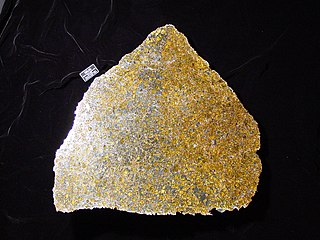
Imilac is a pallasite meteorite found in the Atacama Desert of Northern Chile in 1822.

Tamentit (تامنطيت) is a town and commune or municipality in Fenoughil District of Adrar Province, in south-central Algeria. According to the 2008 census it has a population of 9,481, up from 7,912 in 1998, with an annual growth rate of 1.9%.

Gibeon is a meteorite that fell in prehistoric times in Namibia. It was named after the nearest town: Gibeon.
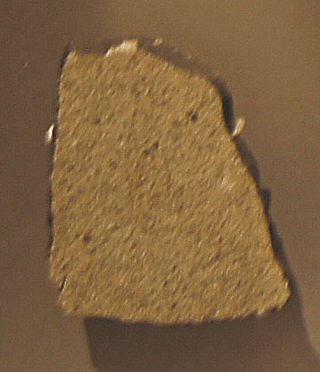
The Sylacauga meteorite fell on November 30, 1954, at 12:46 local time in Oak Grove, Alabama, near Sylacauga, in the United States. It is also commonly called the Hodges meteorite because a fragment of it struck Ann Elizabeth Fowler Hodges (1920–1972).

L'Aigle is a L6 meteorite that fell on 26 April 1803 in Lower Normandy, France.
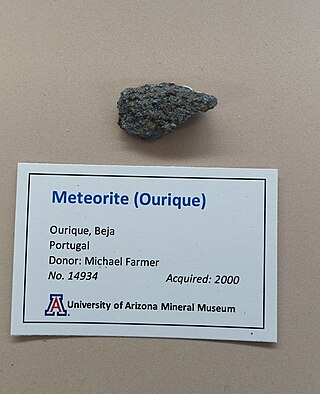
Ourique is a H4 meteorite that fell in 1998 in Portugal.

Park Forest is an L5 chondrite meteorite that fell on 26 March 2003 in Illinois, United States.

The Weston meteorite is an H4 ordinary chondrite meteorite which fell to earth above the town of Weston, Connecticut on the morning of December 14, 1807.
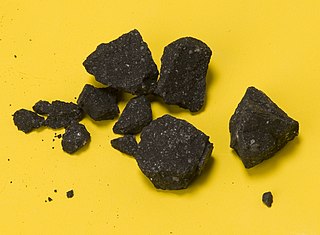
The Sutter's Mill meteorite is a carbonaceous chondrite which entered the Earth's atmosphere and broke up at about 07:51 Pacific Time on April 22, 2012, with fragments landing in the United States. The name comes from Sutter's Mill, a California Gold Rush site, near which some pieces were recovered. Meteor astronomer Peter Jenniskens assigned Sutter's Mill (SM) numbers to each meteorite, with the documented find location preserving information about where a given meteorite was located in the impacting meteoroid. As of May 2014, 79 fragments had been publicly documented with a find location. The largest (SM53) weighs 205 grams (7.2 oz), and the second largest (SM50) weighs 42 grams (1.5 oz).
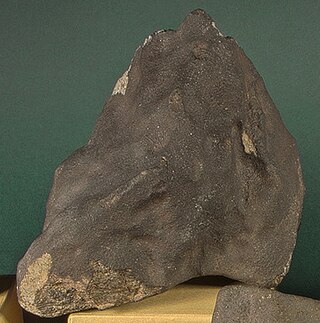
The Tamdakht meteorite fell near Ouarzazate, Morocco on 20 December 2008 producing a strewn field of approximately 25 kilometres (16 mi) by 2 kilometres (1.2 mi) and two small impact craters, one of about 1.1 metres diameter and 70 centimetres (28 in) depth at 31°09.8′N7°00.9′W and the other of about 20 centimetres (7.9 in) diameter and 10 centimetres (3.9 in) depth at 31°09.9′N07°02.3′W.
This is a glossary of terms used in meteoritics, the science of meteorites.

Fifteen pieces of the Kainsaz meteorite were seen to fall near Kainsaz, Muslyumovo, Tatarstan on September 13, 1937. The largest weighed 102.5 kilograms (226 lb), the total weight was ~200 kilograms (440 lb). As of January 2013 pieces were on sale for ~US$100/g. Kainsaz is the only observed fall in Tatarstan.
On 4 May 2014 around 4:17pm (EDT) a daylight bolide occurred near Ontario, resulting in a meteor air burst. The meteoroid was estimated to be roughly 50–100 centimetres in diameter. The explosion was estimated to be equivalent to approximately 10–20 tons of TNT. The meteor was first seen in Peterborough and traveled on a southwest-to-northeast trajectory. A meteor of this size impacts Earth about twice a week.

The Erg Chech, is a large erg in southwestern Algeria and northern Mali.
Dimmitt is a meteorite that fell in prehistoric times in The United States. It was named after the nearest town of Dimmitt, Texas.
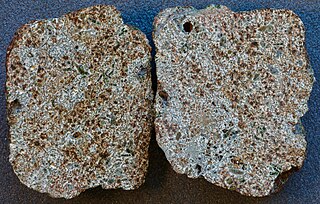
Erg Chech 002 is an ancient andesite meteorite discovered in the Erg Chech region of the Sahara Desert in Algeria. It is believed to be a fragment of a chondritic protoplanet that is over 4.566 billion years old, and is believed to be the oldest known volcanic rock on Earth. It is held at the Maine Mineral and Gem Museum.

















